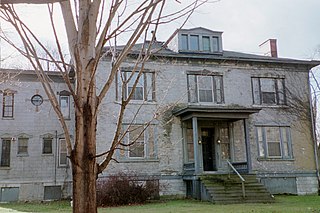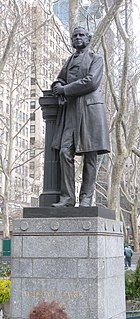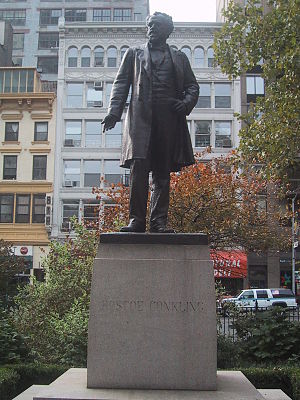
Roscoe Conkling was a lawyer and politician from New York who served both as a member of the United States House of Representatives and the United States Senate. He was the leader of the Stalwart faction of the Republican Party, the first Republican senator from New York to be elected for three terms, and the last person to turn down a U.S. Supreme Court appointment after he had already been confirmed to the post. While in the House, Conkling served as bodyguard for Representative Thaddeus Stevens, a sharp-tongued anti-slavery representative, and fully supported the Republican war effort. Conkling, who was temperate and detested tobacco, was known for his physical condition, maintained through regular exercise and boxing, an unusual devotion for his time. Conkling was elected to the Senate in 1867 as a leading Radical, who supported the rights of African Americans during Reconstruction.

John Quincy Adams Ward was an American sculptor, whose most familiar work is his larger than life-size standing statue of George Washington on the steps of Federal Hall National Memorial in New York City.

Madison Square is a public square formed by the intersection of Fifth Avenue and Broadway at 23rd Street in the New York City borough of Manhattan. The square was named for James Madison, fourth President of the United States. The focus of the square is Madison Square Park, a 6.2-acre (2.5-hectare) public park, which is bounded on the east by Madison Avenue ; on the south by 23rd Street; on the north by 26th Street; and on the west by Fifth Avenue and Broadway as they cross.
Events from the year 1829 in the United States.

The Roscoe Conkling House is a historic house at 3 Rutger Park in Utica, New York, USA. A National Historic Landmark, it was the home of Roscoe Conkling (1829–1888), a powerful and controversial politician. He is responsible, perhaps, for the angry, political atmosphere that led to the assassination of U.S. President James Garfield.

Alfred Conkling was a United States Representative from New York, a United States District Judge of the United States District Court for the Northern District of New York and United States Minister to Mexico.

The 1879 United States Senate election in New York was held on January 21, 1879, by the New York State Legislature to elect a U.S. Senator to represent the State of New York in the United States Senate.

Utica Parks and Parkway Historic District is a national historic district located at Utica in Oneida County, New York. It consists of four contributing historic elements: a historic right-of-way known as the Memorial Parkway and the three large parks it connects: Roscoe Conkling Park, F.T. Proctor Park, and T.R. Proctor Park. The district includes seven contributing buildings, three contributing sites, 26 contributing structures, and five contributing objects. The park and parkway system was designed between 1908 and 1914 by the firm of Olmsted Brothers Landscape Associates, headed by Frederick Law Olmsted, Jr. The Utica Zoo is located in Roscoe Conkling Park.

The United States Senate elections of 1878 and 1879 were elections which had the Democratic Party retake control of the United States Senate for the first time since before the Civil War.

The 96th New York State Legislature, consisting of the New York State Senate and the New York State Assembly, met from January 7 to May 30, 1873, during the first year of John A. Dix's governorship, in Albany.

The 104th New York State Legislature, consisting of the New York State Senate and the New York State Assembly, met from January 4 to July 23, 1881, during the second year of Alonzo B. Cornell's governorship, in Albany.

The Henry Ward Beecher Monument, a statue of Henry Ward Beecher created by the sculptor John Quincy Adams Ward, was unveiled on June 24, 1891 in Borough Hall Park, Brooklyn and was later relocated to Cadman Plaza, Brooklyn in 1959.

Indian Hunter is an outdoor bronze sculpture by John Quincy Adams Ward, located at Central Park in Manhattan, New York. It was cast in 1866 and dedicated on February 4, 1869. The statue was Central Park's first sculpture by an American artist.

William Shakespeare is an outdoor bronze sculpture of William Shakespeare by John Quincy Adams Ward, located in Central Park in Manhattan, New York. The statue was created in 1870 and unveiled in Central Park in 1872. Four thousand dollars towards the funding of the statue was raised at a benefit performance of Julius Caesar on November 24, 1864, performed by the sons of Junius Brutus Booth at the Winter Garden Theater.

Seventh Regiment Memorial is an outdoor bronze sculpture honoring the members of that regiment whose lives were forfeited during the Civil War. The statue was created by John Quincy Adams Ward and the base was designed by Richard Morris Hunt. Although the statue is dated 1869 the monument was not unveiled until June 22, 1874.

An outdoor bronze bust of Alexander Lyman Holley by artist John Quincy Adams Ward and architect Thomas Hastings is installed in Washington Square Park in Manhattan, New York. Cast by the Henry-Bonnard Bronze Company of New York and dedicated in 1889, the sculpture is set on an Indiana limestone pedestal and displays a Beaux-Arts style design.

William Earl Dodge is an outdoor bronze sculpture of William E. Dodge by John Quincy Adams Ward, located at Bryant Park in Manhattan, New York. It was cast in 1885 and dedicated on October 22 of that year.

An outdoor bronze sculpture of Horace Greeley by artist John Quincy Adams Ward and architect Richard Morris Hunt is located in City Hall Park in Manhattan, New York. Cast in 1890, the seated statue is set on a Quincy granite pedestal.


















